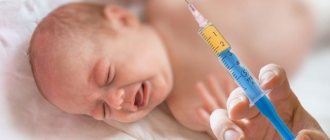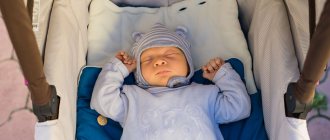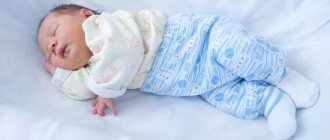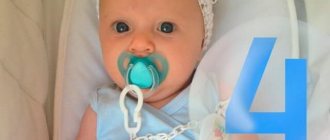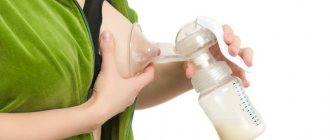Few mothers know that babies are born with an imperfect thermoregulation system. Children from the first days of life to 3 months are not able to maintain a stable body temperature, so they react very sensitively to fluctuations in external temperature.
When it comes to children's clothing, many mothers are overly zealous and try to wrap their baby up so that he doesn't get cold during walks and at home. But with improper care, there is a risk of hypothermia or overheating of the child. In what cases is it appropriate for boys and girls to wear a hat to make them feel comfortable?
Is the baby cold or hot?
An inexperienced mother should know the basic rules for determining temperature for a small family member:
- You should never rely on a thermometer that shows the temperature of a room or street, and even more so, on your own sensations and well-being.
- What needs to be taken into account is not the condition of the baby’s fingertips or nose, but the area of the feet, upper back, folds of the neck and crown.
- The main indicator is humidity (the child is hot and sweating) or, conversely, the coolness of certain parts of the body (the baby is cold). If in the first case it is necessary to change the baby into lighter clothes, then in the second, of course, you need to dress the baby warmer.
The best room temperature for a baby is 25-27 degrees Celsius.
Features of home clothes
An infant cannot take care of himself. His parents should do this. In this case, home clothes for nursing mothers play an important role. She should be as comfortable as possible in performing all tasks around the house.
However, what you need to consider when choosing clothes for your baby:
- During the hot season, mommy should use a minimum number of things. To improve thermoregulation, you can remove the diaper. It contains various components, due to which the baby may overheat. Clothing must cover the genitals. You can use regular cotton panties for this.
- When choosing clothes, it is necessary to focus on the baby’s feelings. The room temperature can change several times a day, so there is a need to change clothes. The baby can wear a T-shirt, rompers, bodysuits, knee socks and overalls. Today, any children's store offers a wide range of products from this group.
- It is quite possible to refuse a hat if the child is already three months old. Bonnets should only be used outdoors during cool times of the day. The material should be pleasant and not cause skin irritation.
Your baby should be warm and comfortable at home
How to properly dress a newborn?
A newly born baby should be dressed exclusively in natural materials, which include mainly “breathable” cotton and flannel fabrics, as well as lightweight knitwear.
Synthetics are strictly contraindicated: in the summer the baby sweats, and in the winter he freezes!
At home, one or two vests, rompers or light overalls are enough. If your baby's arms and legs are cold, he should wear sleeves and socks.
As for a hat, cap or scarf on a newborn’s head, there is no clear answer to this question either among “experienced” mothers and grandmothers, or experienced pediatricians.
There are two completely opposite opinions: some assert with complete confidence that a cap at home is mandatory even in hot weather, others believe that a cap should be worn depending on the situation - when going out onto the balcony or, in extreme cases, after taking a bath, and then only for 20-30 minutes, until your head dries out.
The baby’s weight is the main parameter that the mother monitors. What determines the weight of a child at birth and how a child should gain weight - read carefully.
Crafts from colored paper for children - see what you can make here.
We will tell you in this article how to teach a child to read at five years old and what methods to use.
Types of caps for newborns
Hats for babies should be soft, light colors, made of natural fabrics, preferably cotton. In such hats, children do not get hot or cold, they do not sweat, and the delicate skin of the back of the head does not become irritated or subject to diaper rash.
Modern stores offer a huge variety of caps for newborns, differing in color, shape and design.
Smart cap
When choosing hats for babies, you need to take into account the following features:
- the cap should be soft, hygroscopic, allow air to pass through well, not tightly fit the baby’s head and at the same time not bunch up;
- when purchasing caps, you should focus not so much on the age parameters indicated by the manufacturer on the label, but on the size of the head of the newborn itself;
- It is advisable to avoid bright hats, with various pictures or ornaments, since fabrics with pictures can cause allergies in the baby.
The best choice is a plain cotton cap with wide and soft ribbons.
Babies' reaction to temperature
Immediately after birth, a child’s internal organs do not function as stably as those of an adult. However, you should not constantly wrap it up. This increases the risk of heat shock.
If your baby is dressed warmly or is constantly in a room with a high temperature, then his risk of overheating increases. Pediatricians say that the baby will be most comfortable at a temperature of 23 degrees. If this indicator becomes lower, then it is permissible to cover the baby with a thin blanket.
Over time, the baby will improve the process of thermoregulation by adapting the work of the sweat glands. With their help, excess heat will be removed from the body. The accumulated fat will allow you to keep it inside if necessary.
Clothing should be made from natural fabric
You should dress your baby carefully at home. In this case, his well-being and other characteristics of the body play an important role. After a certain period, mommy will be able to instantly recognize his signals. This will ensure that you avoid heat stroke. In the first year of life, the baby is not allowed to be wrapped. If he is regularly exposed to high temperatures, he may experience heatstroke, which will lead to seizures.
Arguments for the cap
It is believed that the body of a newly born baby is still disproportionate, and the head is larger than the rest of the body.
For this reason, a newborn needs a light hat at any time of the year to protect him from possible drafts, temperature changes between rooms within the same apartment, and also to cover the baby’s still fragile fontanel.
Hats for a newborn should be light in the summer and moderately warm in the autumn-winter months and in no case contain buttons, snaps, tight laces and other various accessories, as well as hard and rough seams.
Mothers who advocate wearing a hat at home at any time of the day should be very careful, since the cap, as a result of involuntary movements of the head, can fall to the side or cover the baby’s face, which will lead to a lack of oxygen and difficulty breathing.
Arguments against the bonnet
Firstly , only a born person has practically the same rights as other family members. If a healthy adult would never think of wearing a hat at home, then for what reason does a newborn need to cover his head?
Knitted cap
Secondly , the less you wrap a child, the healthier he will grow. Inside the rooms, the air temperature is never changeable, and the cap, in turn, fitting tightly to the head, creates a kind of greenhouse effect, causing only harm to the newborn baby and preventing the baby’s delicate skin from breathing.
Whatever the parents’ decision on the issue of whether to put on a newborn cap (cap, scarf), you should always remember the advice of the famous pediatrician Komarovsky that the baby’s skin should breathe.
Advantages and disadvantages of putting a cap on a newborn at home
Constantly wearing a headdress can lead to the following negative consequences:
- a sweat patch appears on the lower part of the back of the head;
- excessive wrapping leads to a natural result - frequent colds, you just need to blow a little breeze;
- the complete lack of hardening of the child is a counterbalance to a healthy lifestyle.
A newborn's constantly exposed head can cause:
- diseases of the middle ear or the development of meningitis;
- bending of one of the ears, since the baby may involuntarily lie on the ear during sleep.
All mothers panic if they notice their child is underweight. Indeed, this should be taken seriously, because sometimes lack of weight indicates internal pathologies.
Crisis of 3 years - what does it mean? You will find the opinions of psychologists in this topic.
What happens in practice?
Most young mothers start from a specific situation and adapt to the circumstances: they put on a cap after bathing, ventilating the children's room, when the heating is turned off, and also if the room temperature drops below 20 degrees Celsius, etc.
There are no compromises in the issue of putting caps on the head of a newborn: the older generation - grandmothers and mothers-in-law - are ardent supporters of wearing a cap at home up to one year old, modern pediatricians and new mothers believe that overheating is much dangerous for the baby’s health.
The newborn should have the same number of layers of clothing as the mother + one more.
What is the correct air temperature in a newborn's room?
According to leading pediatricians, a temperature of +18-20 °C is considered correct and comfortable for infants. It removes excess heat through breathing and sweat. If the ambient temperature is lower than the baby's body temperature, excess heat is lost along with exhalation. But if the room is too hot, the baby begins to sweat a lot. This is the body's natural reaction to overheating. But excessive sweating often leads to the appearance of a rash on the baby’s delicate skin and crusts in the nose, which make breathing difficult.
Constantly high ambient temperatures threaten dehydration of the child's body, which can result in serious health problems. The baby begins to swell, this is accompanied by painful sensations, restless sleep, and whims.
In the baby's room, the temperature needs to be regulated and controlled. Any differences must be eliminated as quickly as possible so that the baby does not suffer. You should definitely place a thermometer near his sleeping place, which will help monitor the climate.
In summer, when the temperature rises, the room must be air-conditioned. But the main thing is to protect the baby from the direct influence of air flows from climate control equipment. The main thing is to choose the safest place in the room for the baby’s crib, where there are no drafts or air conditioners nearby.
In winter, the thermometer readings can show a temperature range of +25+26 °C. In order to maintain a temperature suitable for the baby in such conditions, you need to ventilate the room more often (in the absence of the child).
You can get out of the situation in another way. For example, remove excess clothes from the baby and leave only a diaper. In conditions of high temperature, he needs to be given water and bathed more often to prevent dehydration (this is life-threatening).
It is also important to maintain humidity in the children's room. The hygrometer column should show 40-60%. At lower humidity, viruses, fungi and other parasites may appear in the house and harm the baby's health.
Which newborns need bonnets?
Firstly, light hats are required for weakened and premature babies, as well as children with colds.
Secondly, there is a category of babies who like to wear a hat; they become less capricious and quickly calm down when putting on a light headdress.
Thirdly, after bathing, newborns born with hair on their heads are usually put on either a cap, or most often a corner towel with a hood, so that the hairs dry quickly and the child does not catch a cold.
To summarize, in the matter of putting on a cap for a newborn, a mother should proceed from the general well-being of the baby and the factors surrounding him, since there are still no absolutely precise and one hundred percent rules by adhering to which one can prevent all childhood diseases that are characteristic of babies at the growing stage.

